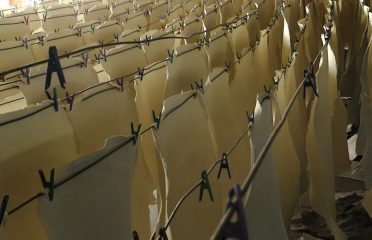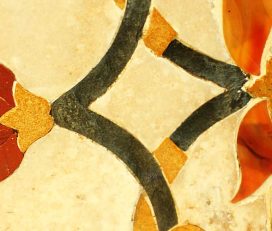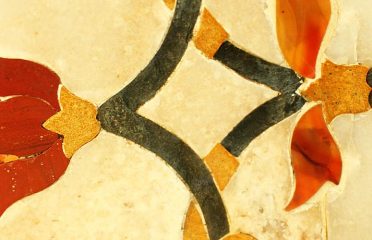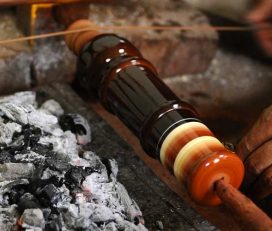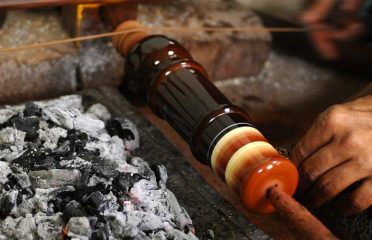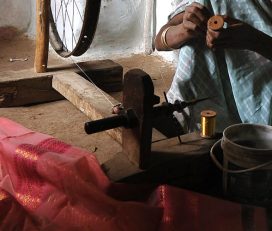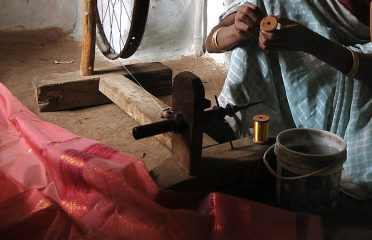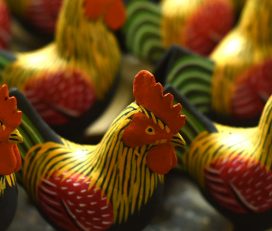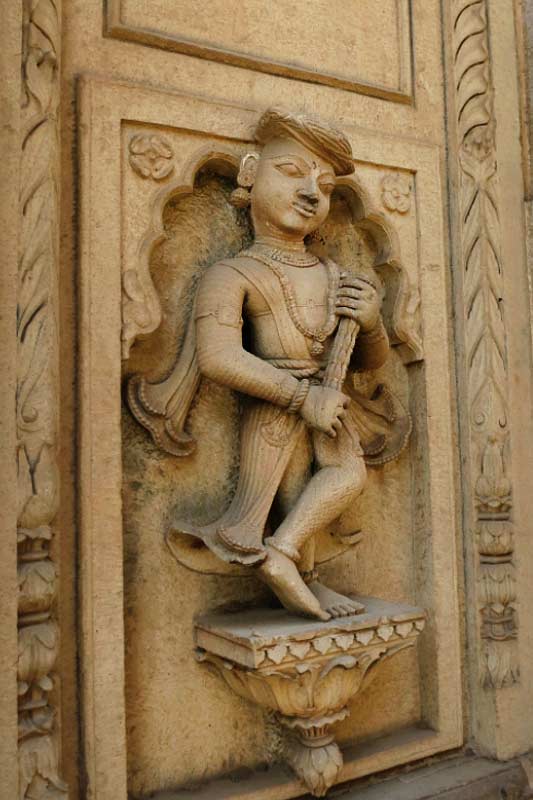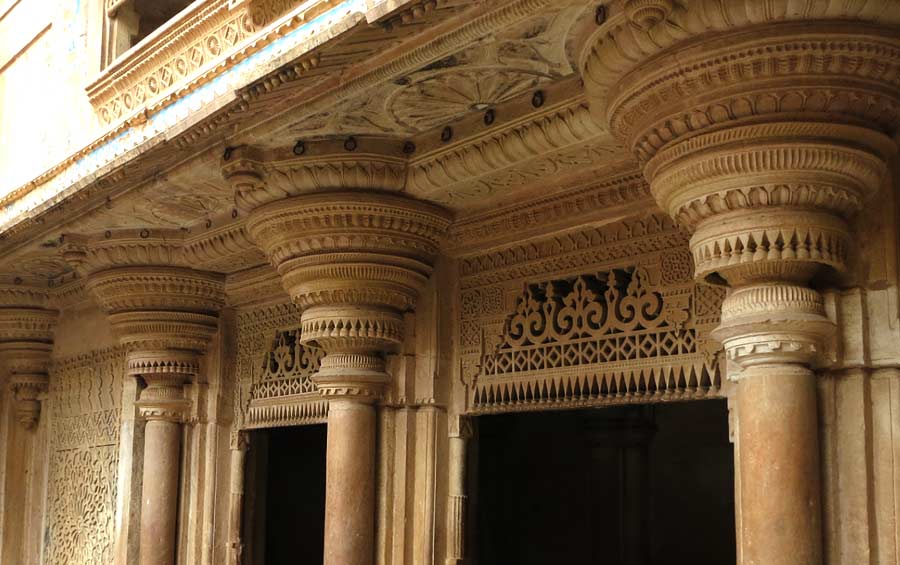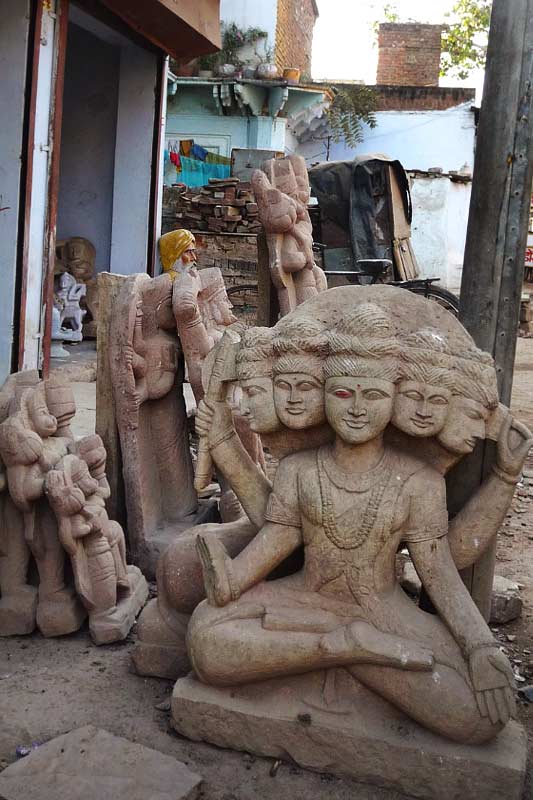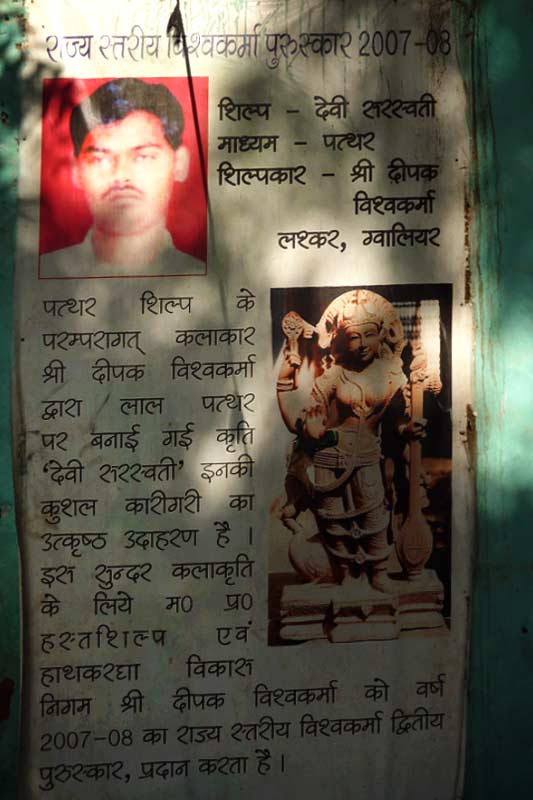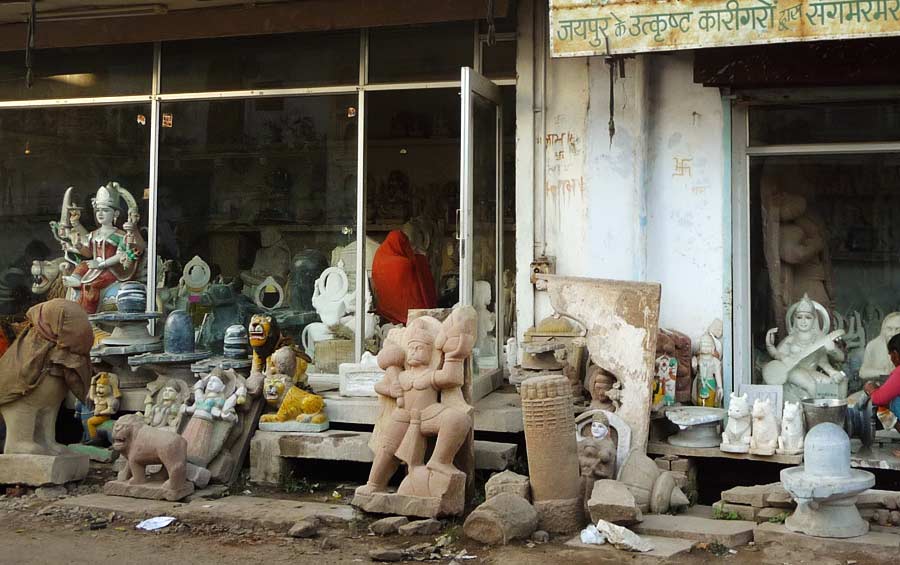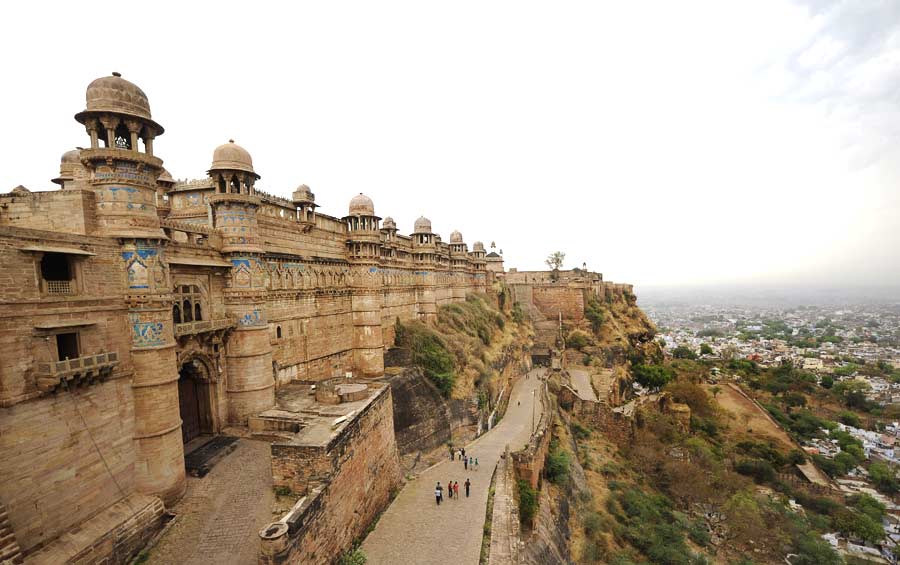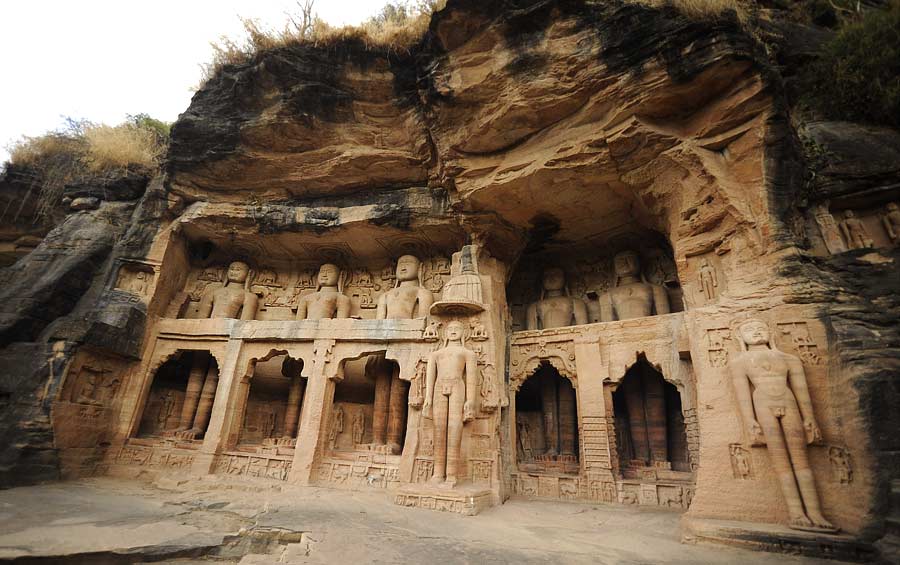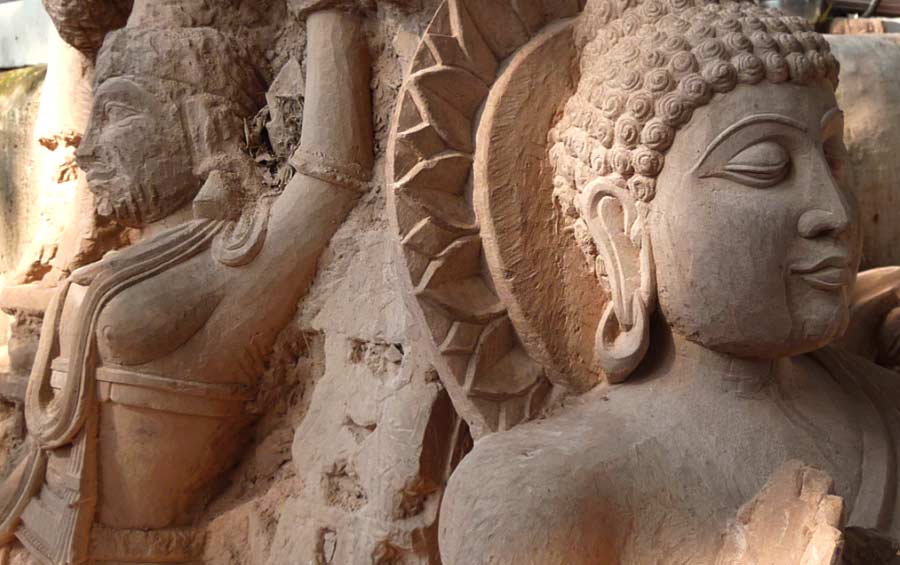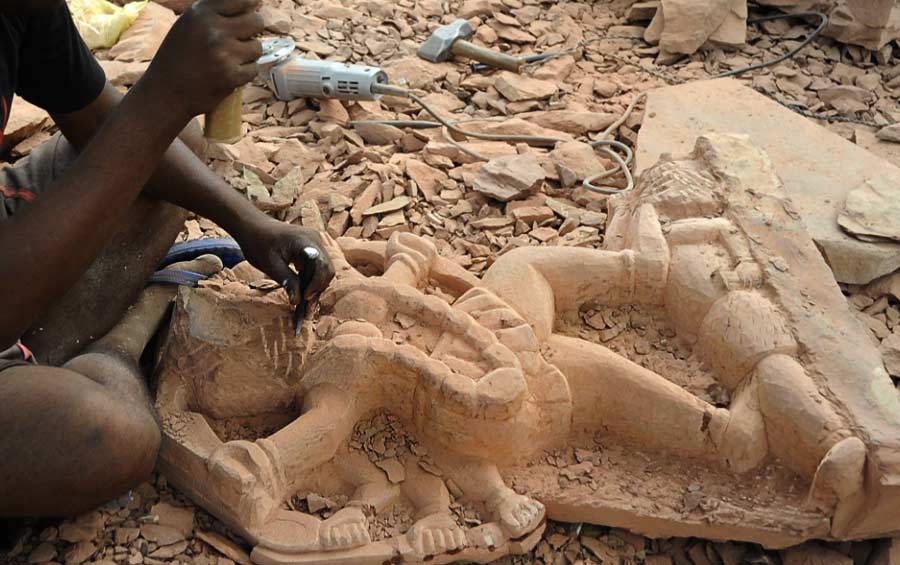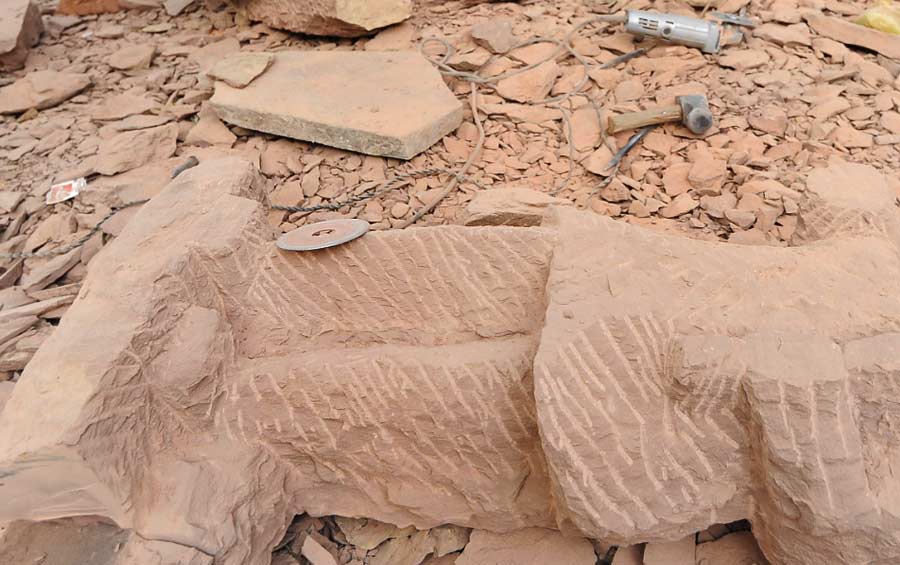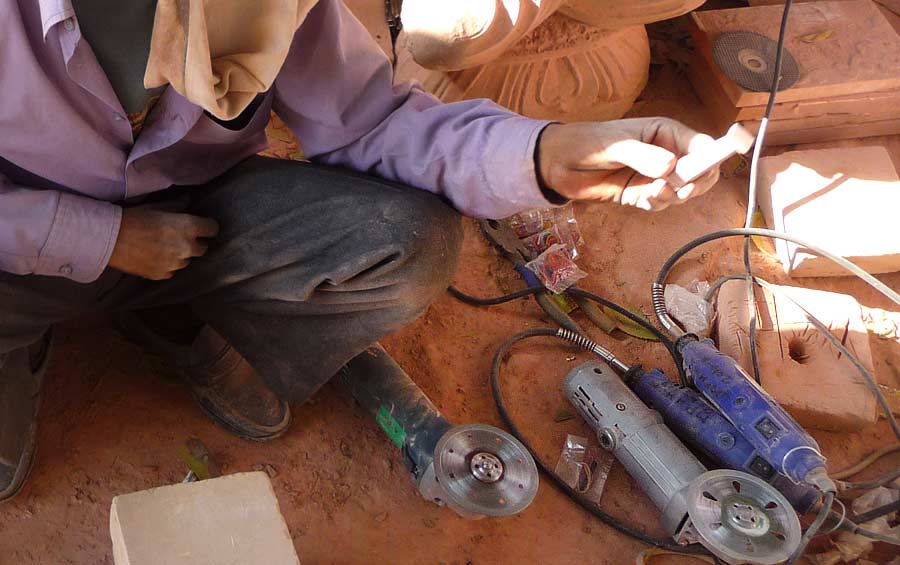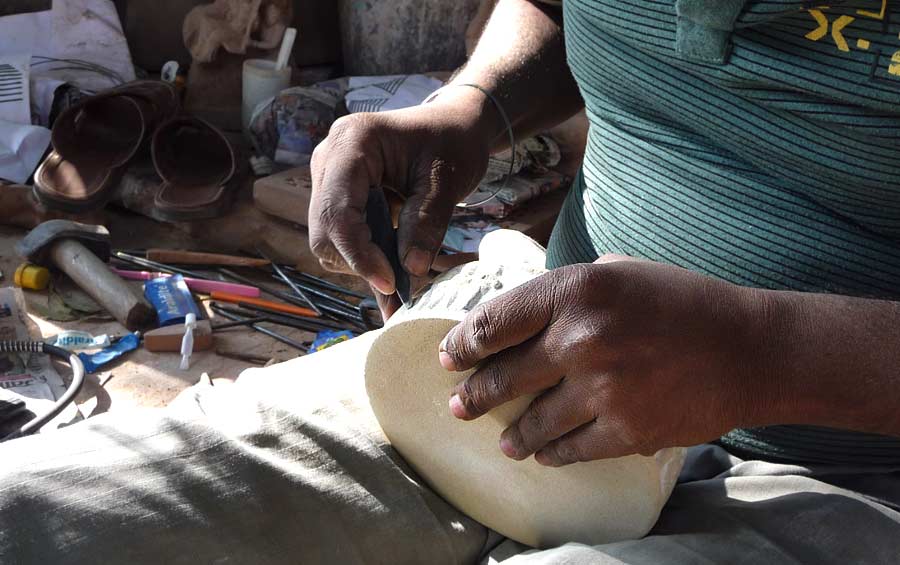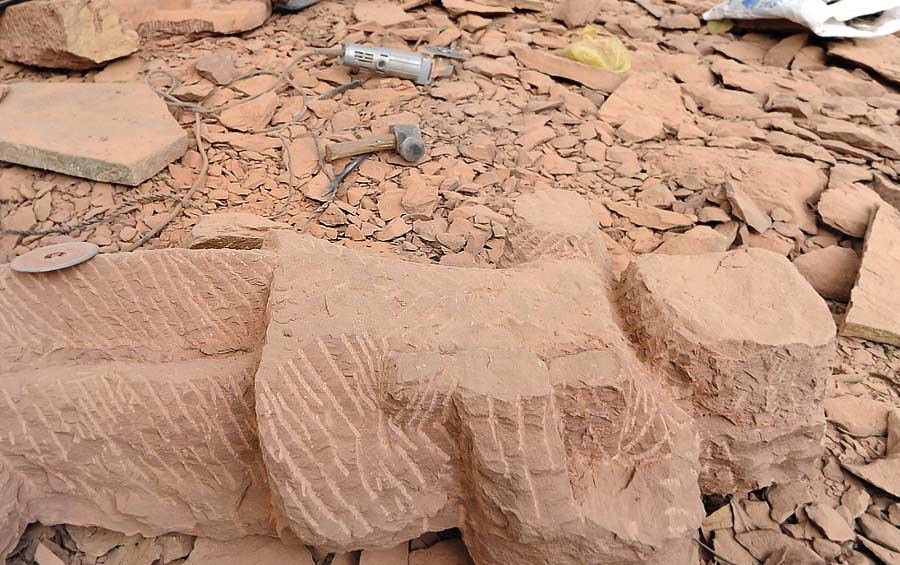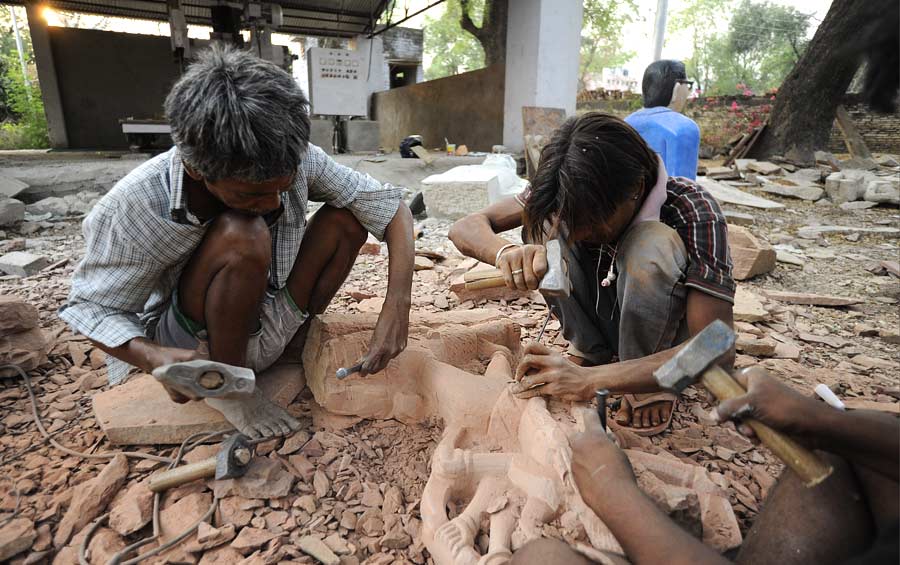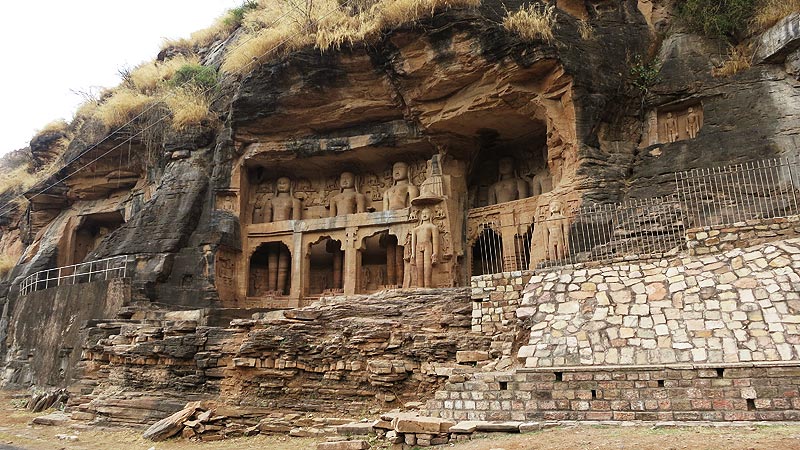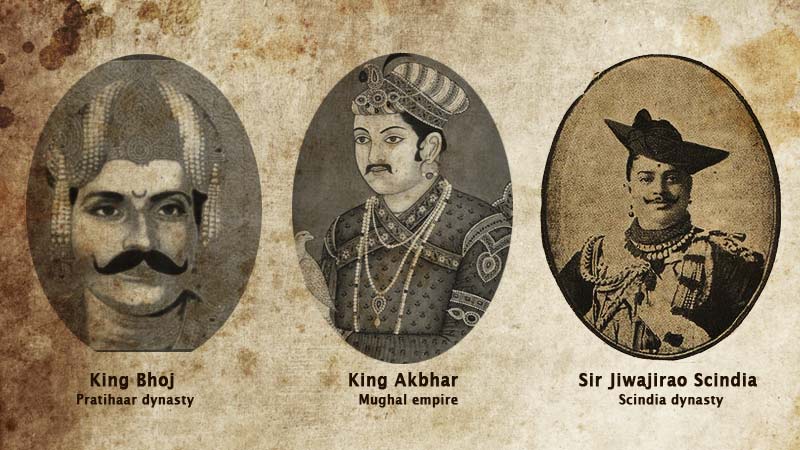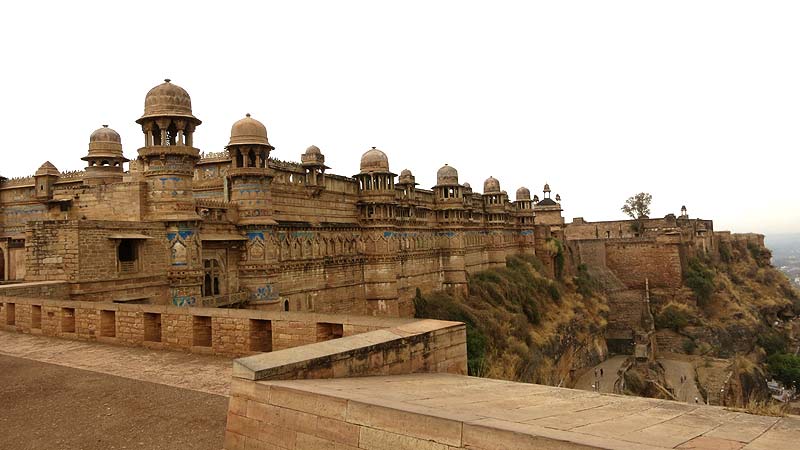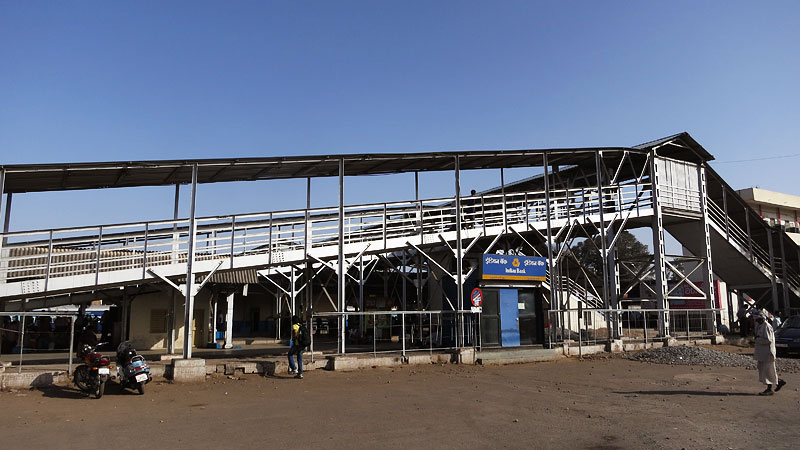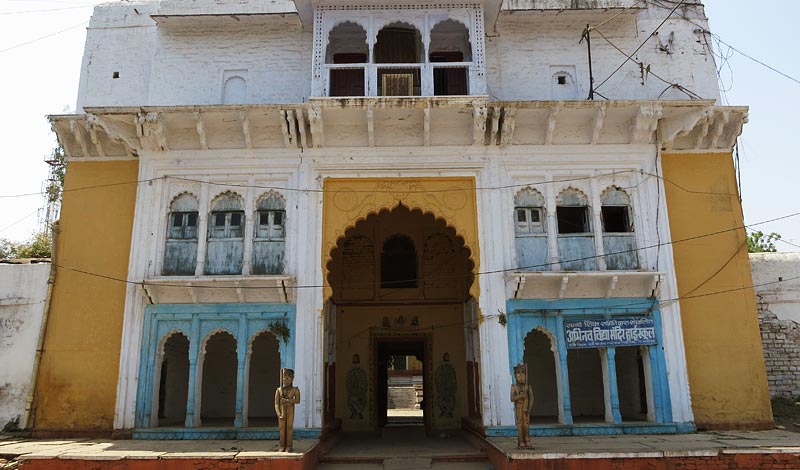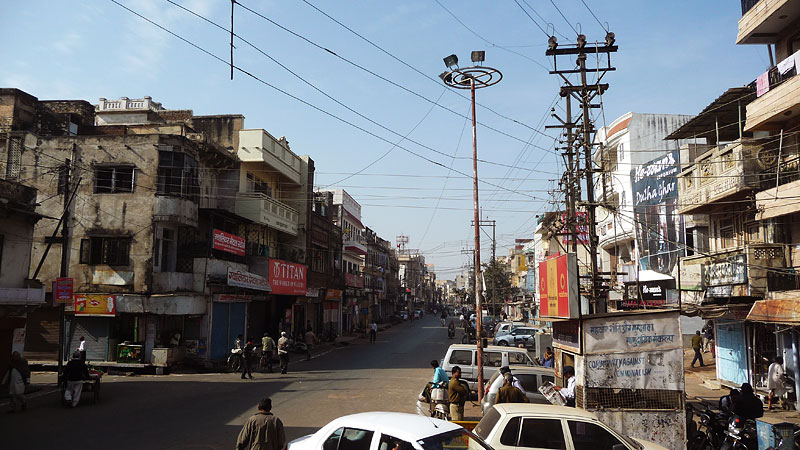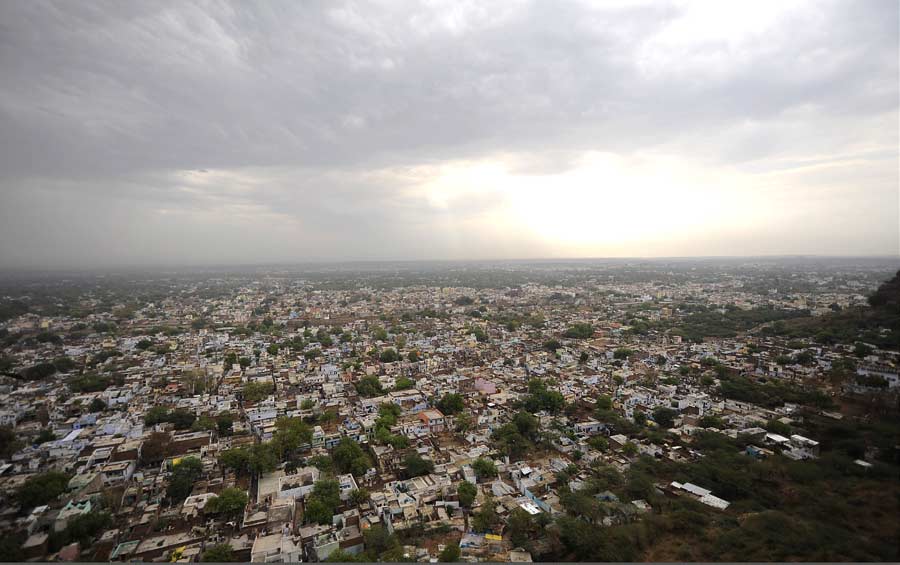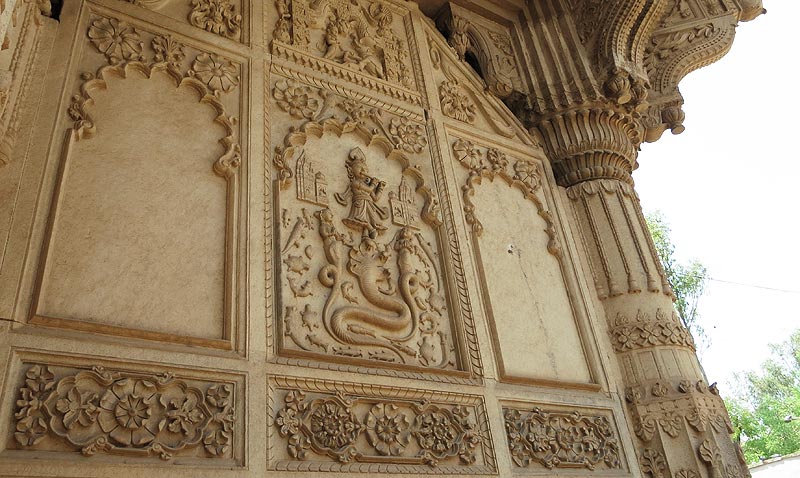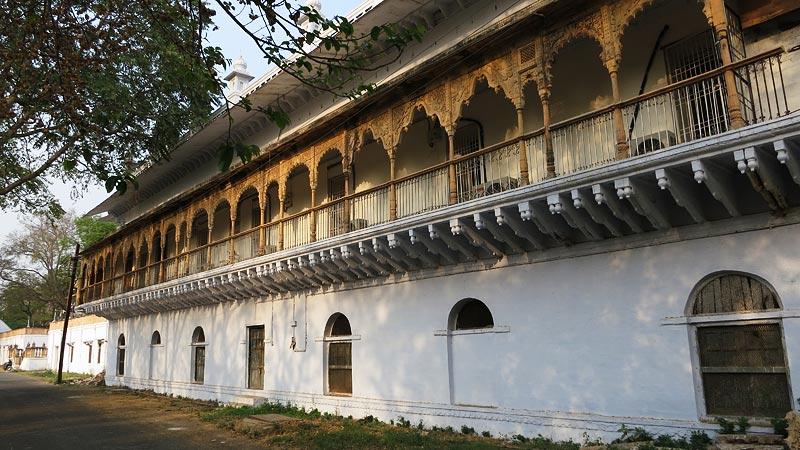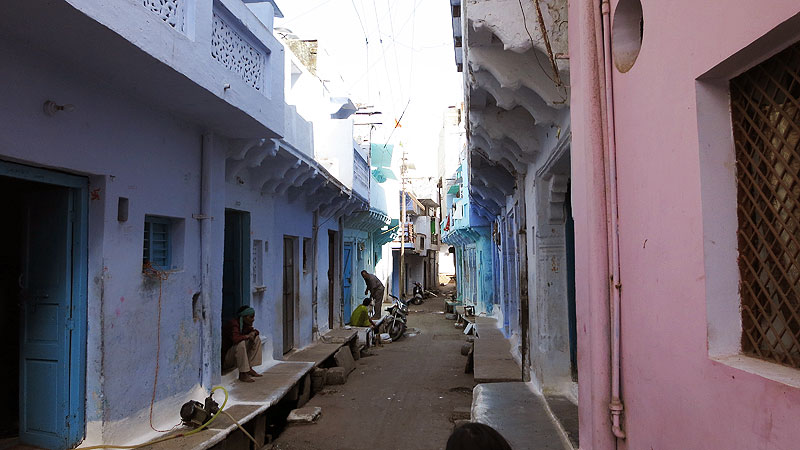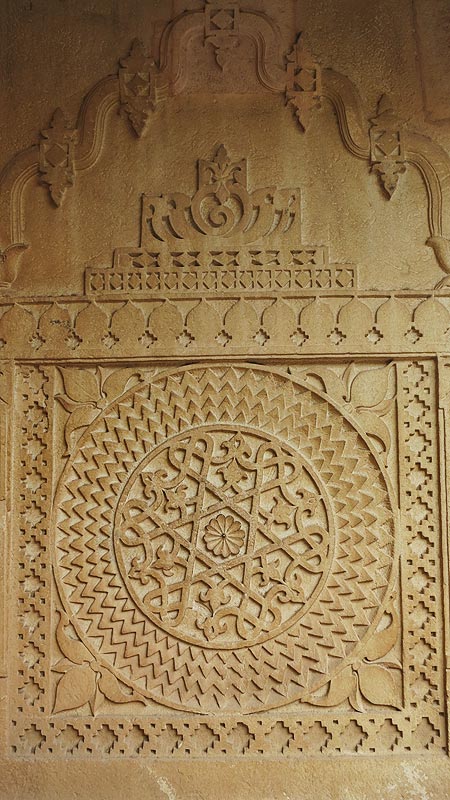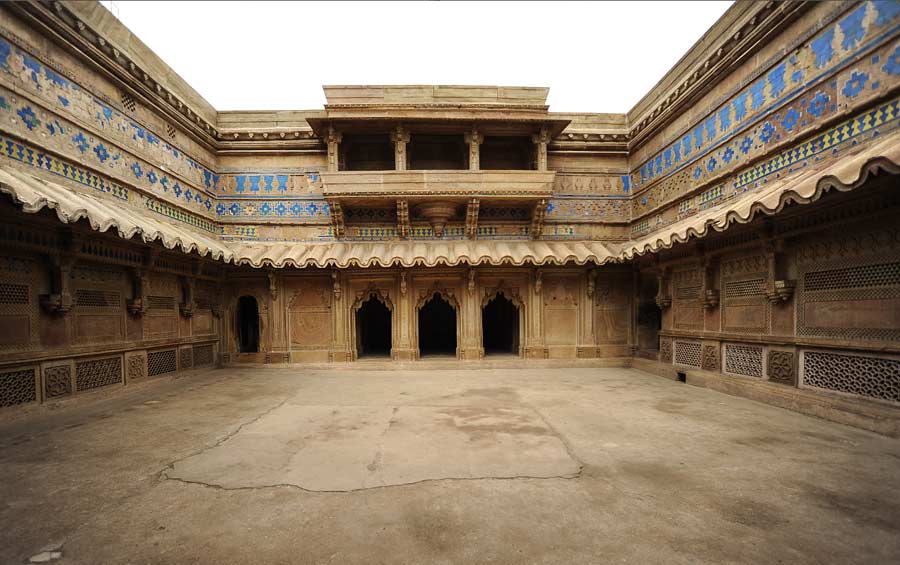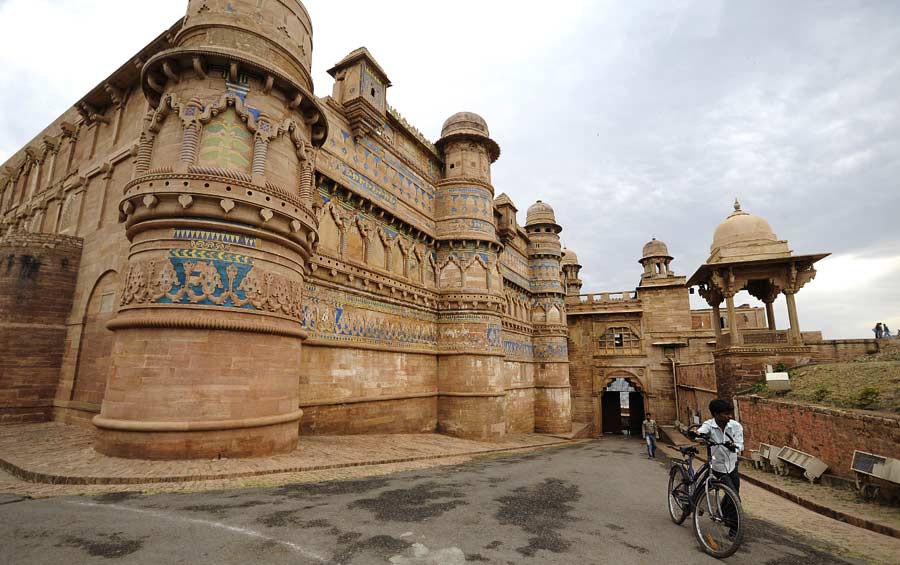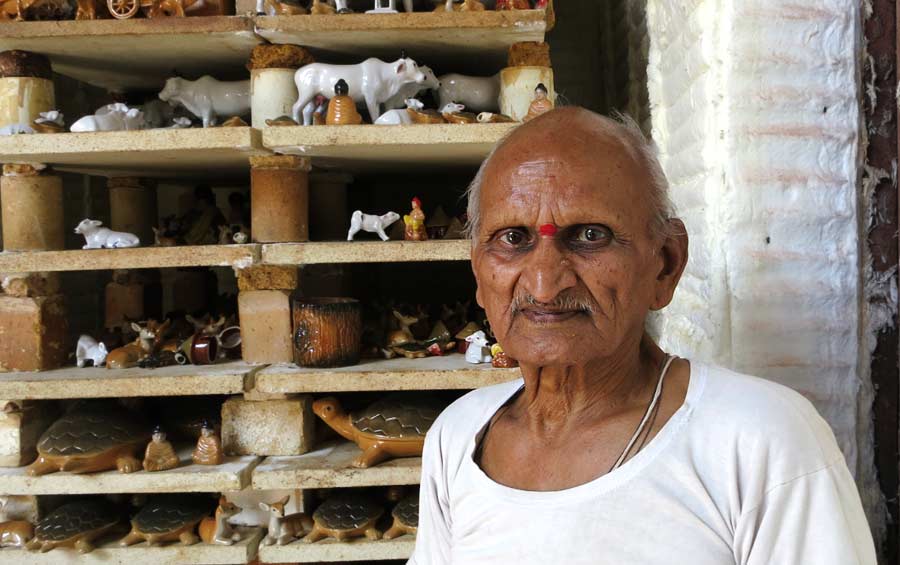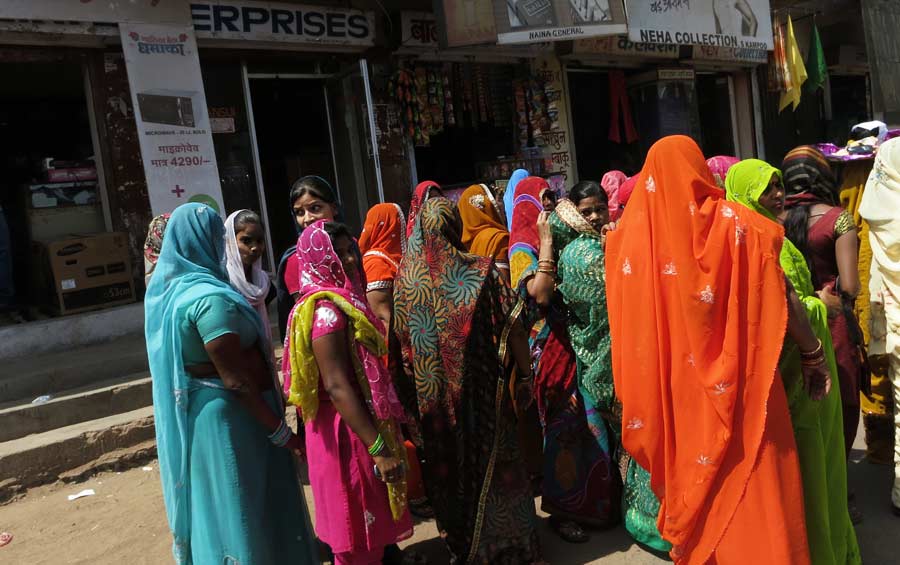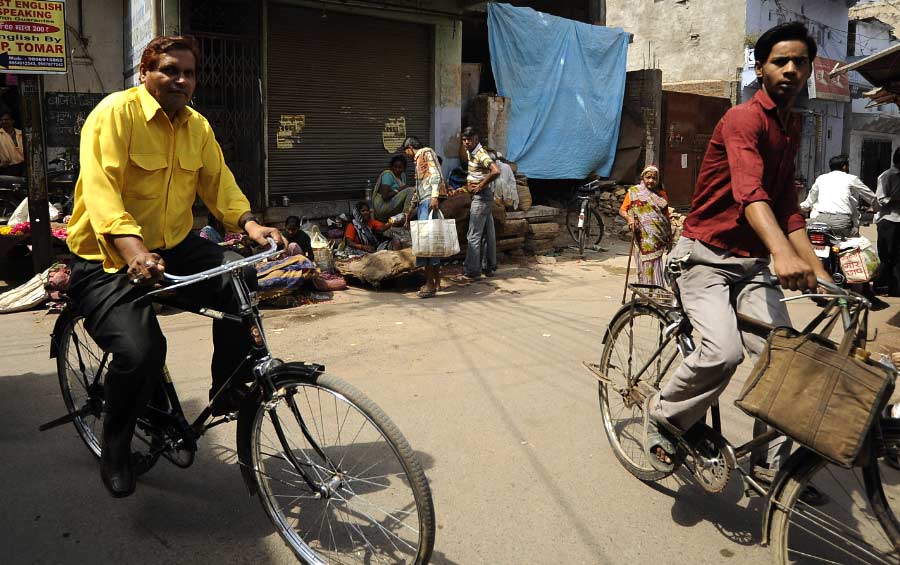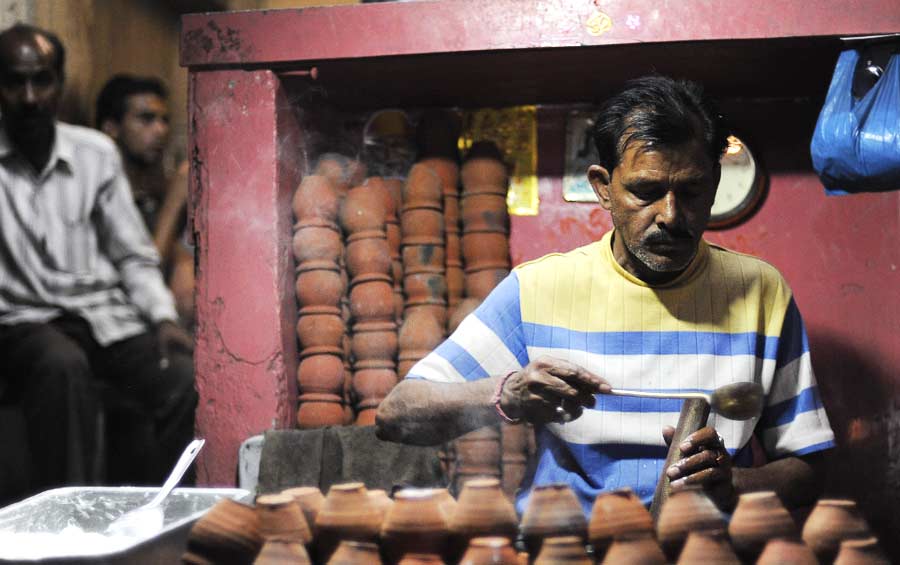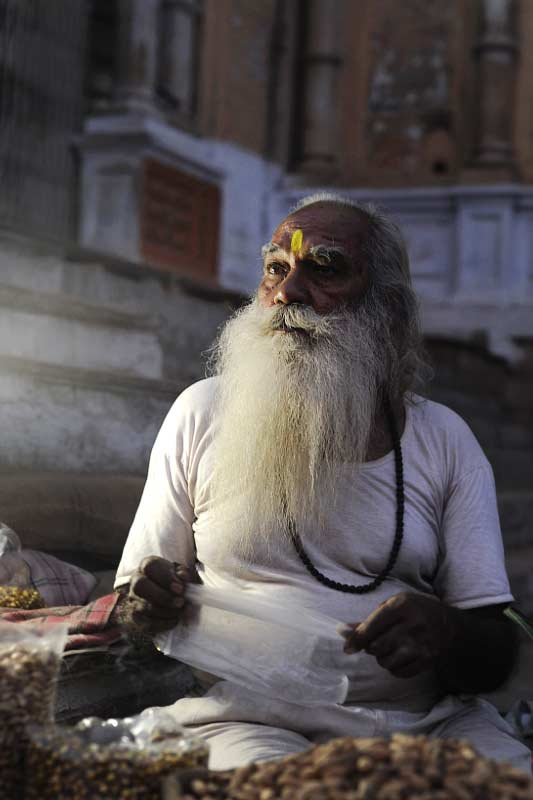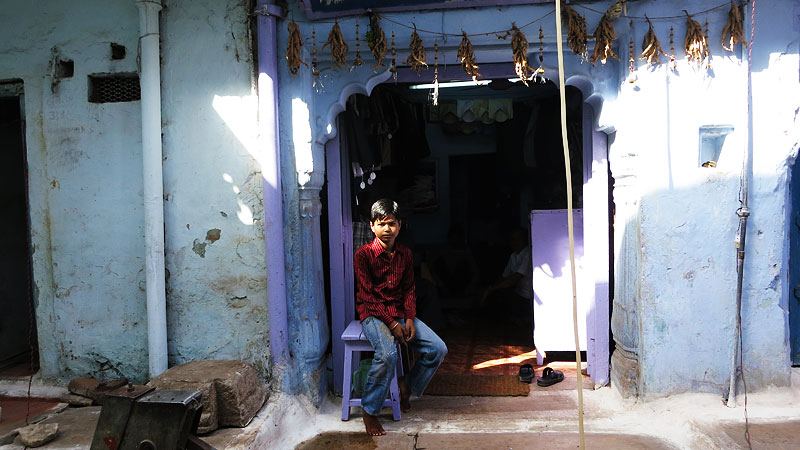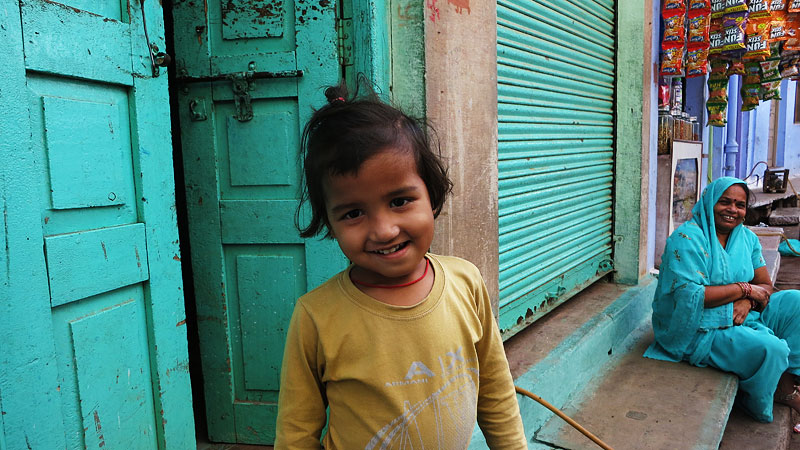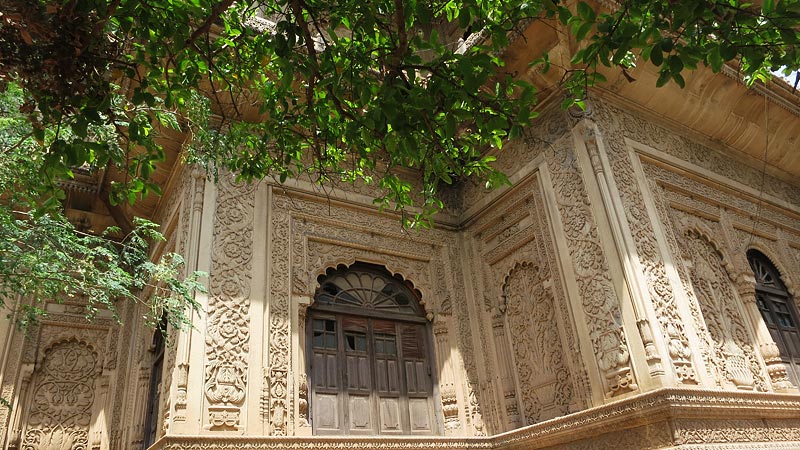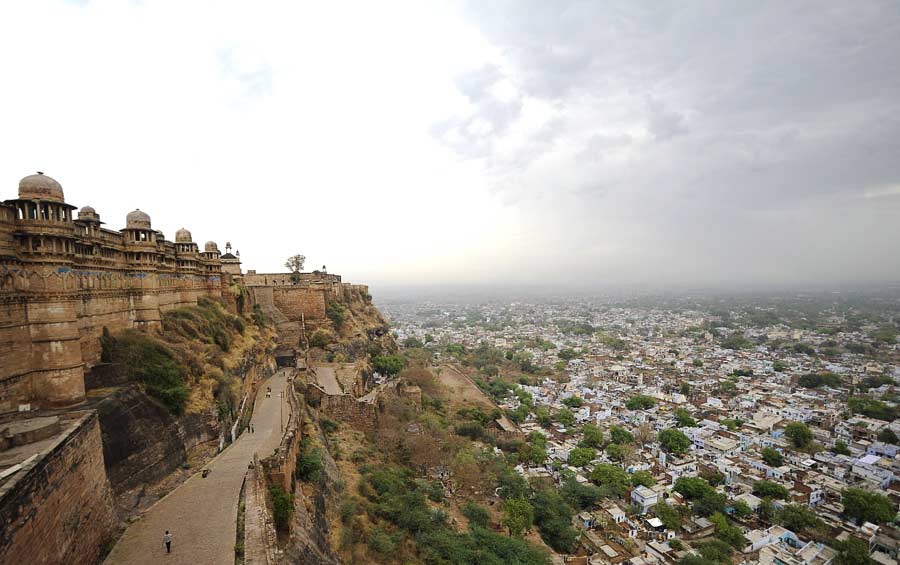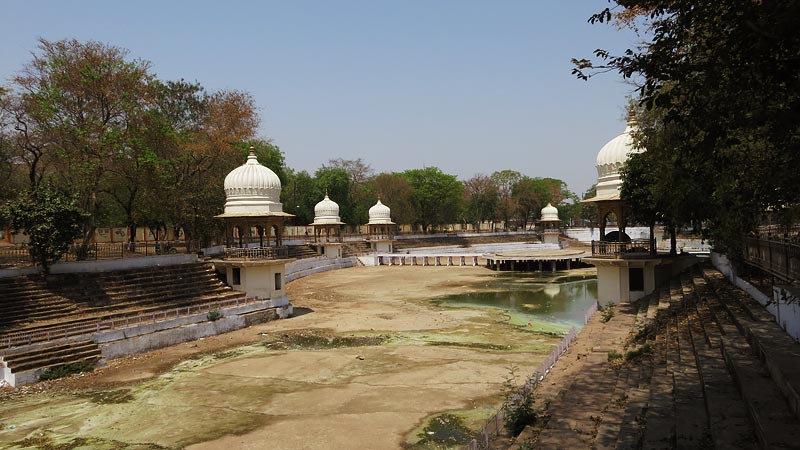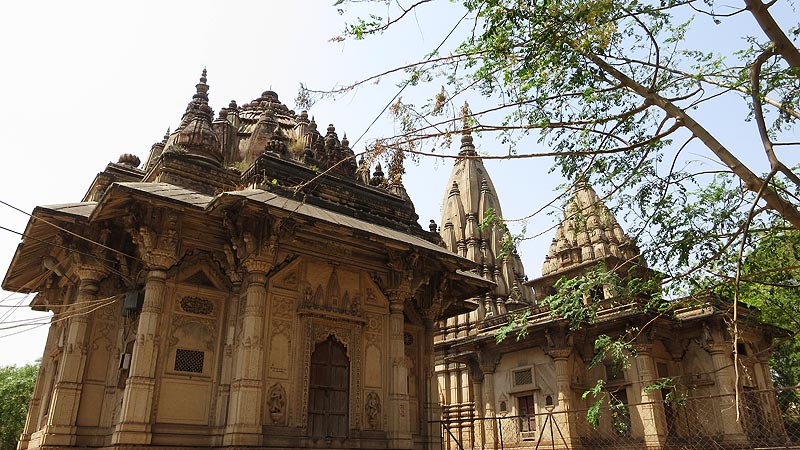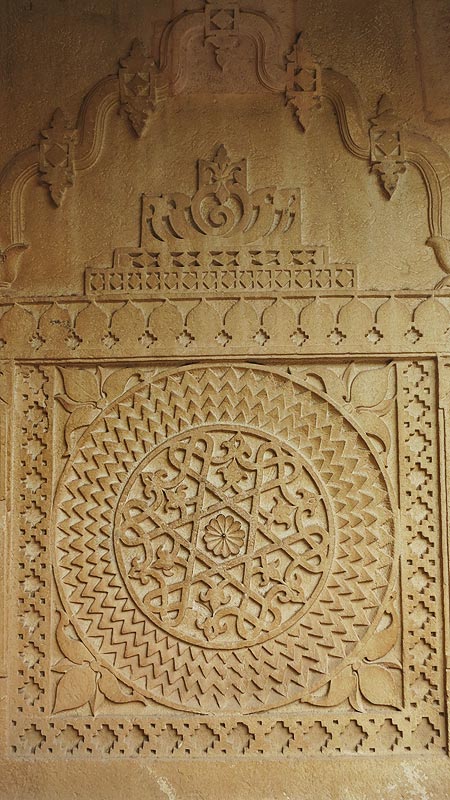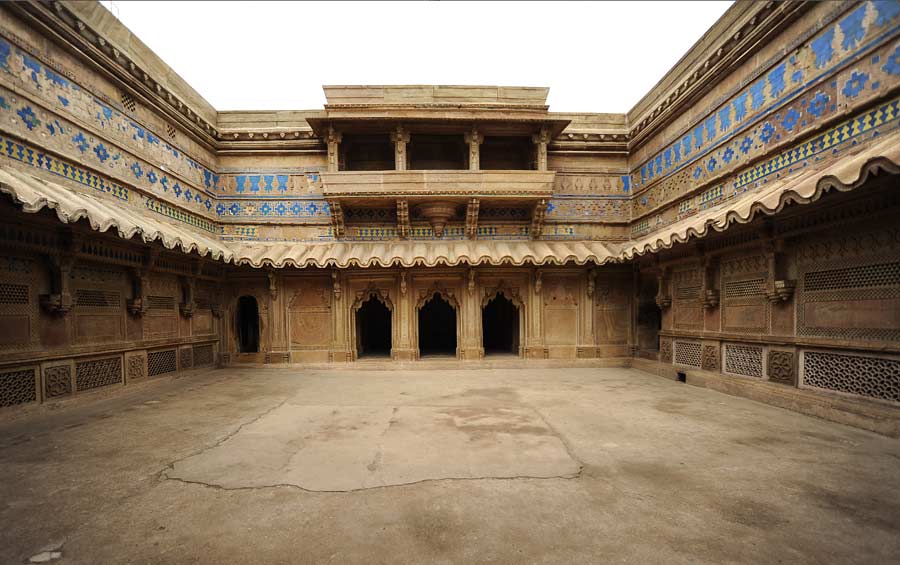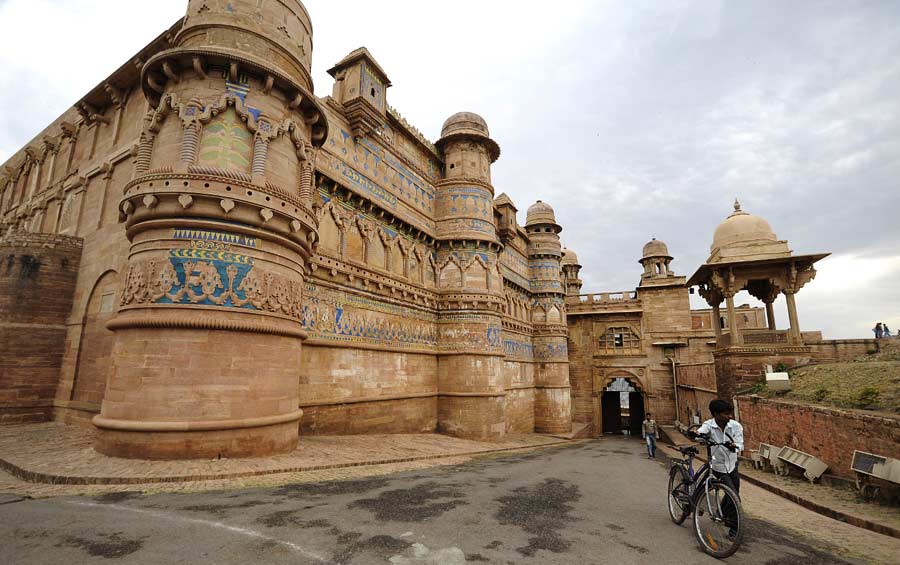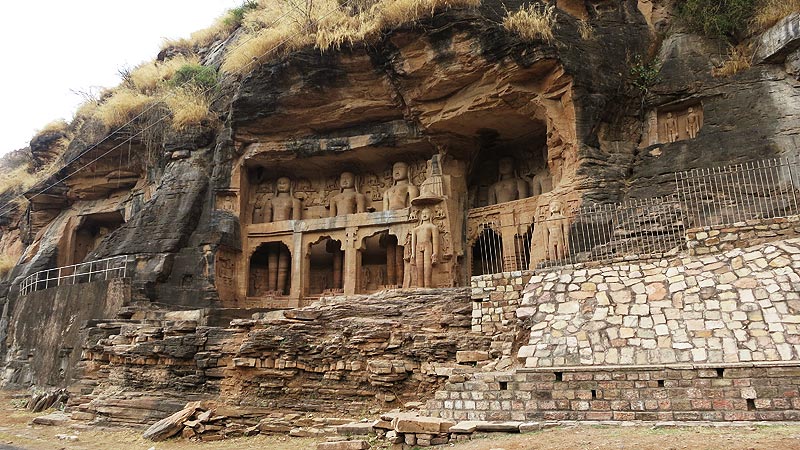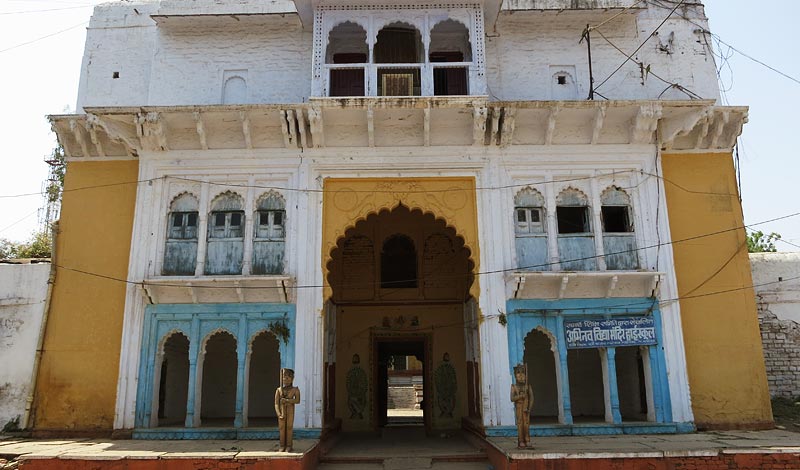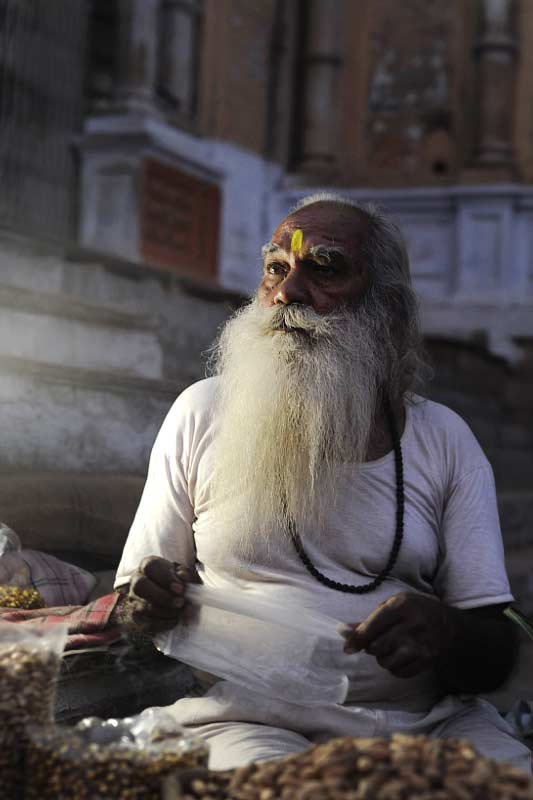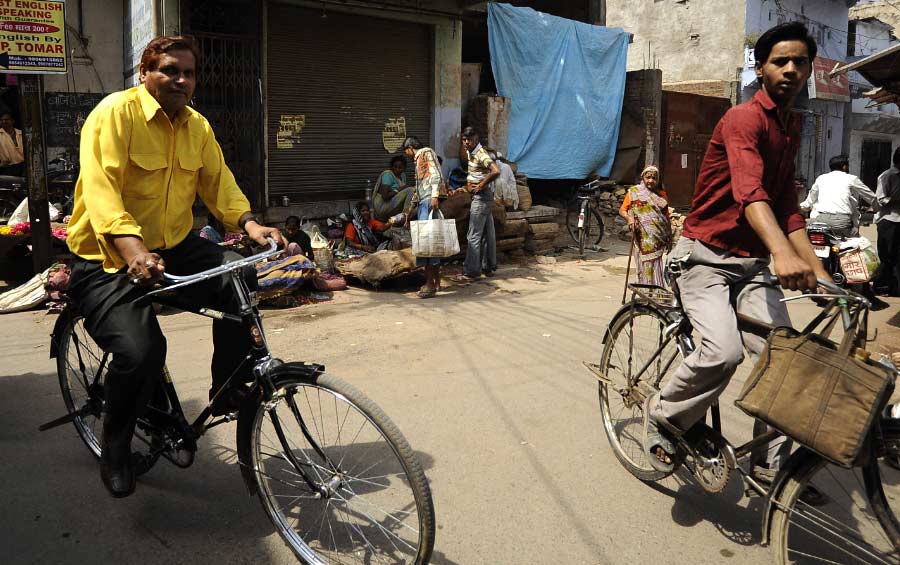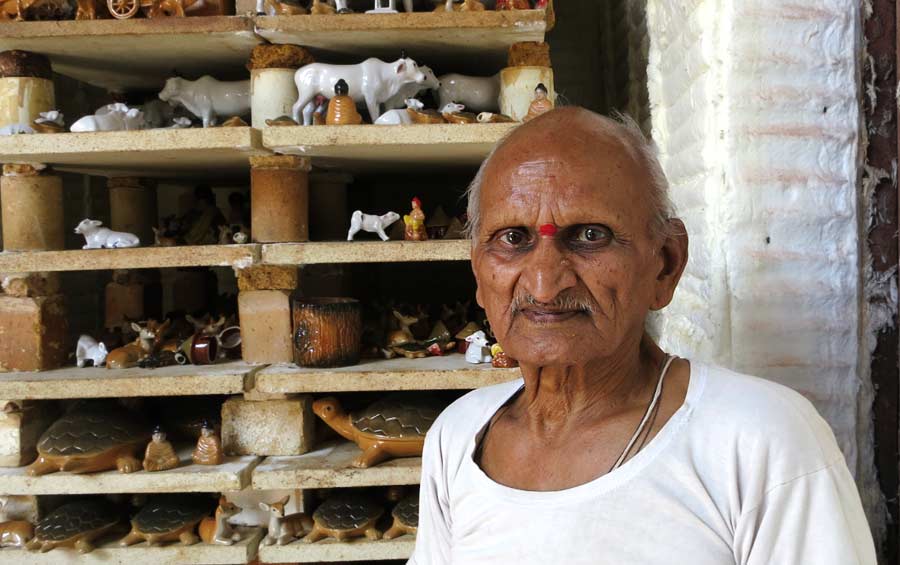Introduction:
Usage:
Many traditional and contemporary products are carved out of stones in Gwalior. The sculptures of various deities are sculpted to perfection. Some sculptures are directly ordered by temple authorities for the installation at temples. These sculptures are also exported overseas. Ornamentation for buildings such as columns, fixtures, lattices, show pieces constitutes a significant part of stone carving production at Gwalior. Specific sculptures such as fountains, garden furniture and urban installations are also made by craftsmen. Stone carving has seeped into other uses such as intricately carved stationary items, kitchen utensils and photo frames. The new generations of craftsmen keep experimenting with the stone medium and contemporary designs, still the traditions of the age old craft are in kept intact.
Significance:
Beautiful votive sculptures are hand-crafted out of stones in Gwalior. These are carefully chiseled to perfection according to the needs of the customers. The craftsmen sometimes bring in marble work or unfinished statues from Jaipur and chisel away their creativity on them. A craft that once covered the expanse of the kingdom is now confined to a street in Gwalior. A craftsman named Deepak Viswakarma who learnt the craft from his father, won a national award for his elegant stone sculptures.
Myths & Legends:
Shilpaic tradition is an ancient tradition of stone carving and the stone carvers are called as Shlipkar. According to this tradition, stone is a living entity. The Shilpkar call it “Shakti Paravastu- which mean the “ultimate luminous substance-. Stone is believed to live longer than any other material on earth. As per Shilpaic tradition, there are three kinds of stone: one that produces a resonant sound like bell, another type of stone produces a long and slender note and the third type doesn’t create any sound, hence it dampens the vibrations, these three types of stones are called male, female and the neutral one respectively.
The shastras (sacred texts) prescribe the male stone for carving male deities, the female stone for female deities and the neutral stone to build temples. When a carver carves a stone, a yogic intimacy develops between a stone carver and a stone; hence the shilpi that results is always joyous and imbibed with good spirit. It is also believed that a sad form or a sad shilpi has adverse effects on its worshiper. When these spiritual concepts are internalized by the artisan, this is when a sculptor gets converted into a sculpture and an architect becomes architecture. A great emphasis is put upon the moral code of sculptor, as he is the one who creates sacred forms through his thoughts.
History:
Stone has withstood the corrosion of time and lived to tell the tale of many civilizations. Readily available, temperature resistant, strong and durable, stone was the first material to be used as tool or first material on which human race ever worked upon. The craft of stone carving is not novel in India but has attained different connotations, scales and uses over time. From the stone carvings in Indus valley civilization to the sculpted caves of Ajanta and Ellora (2) , stone carving in Gwalior is a craft passed on over generations. As most examples in history, whenever forts and palaces were commissioned, the materials at which land was naturally rich in, were put to use; in Gwalior too, the strong stone from the Vindhyachal ranges was transformed into architectural elements, sculptures and utilitarian objects. The craft saw its peak during the reign of Scindia dynasty(4) in 18th and 19th centuries. The Gwalior fort (1) built between the 8th to the 15th century was an architectural wonder. Mughal emperor Babur called it ‘the pearl in the necklace of the forts of Hind’. The fort was a masterpiece in stone and houses various beautiful figures of gods, deities and mythical creatures. With various influences of the rulers and rulers which passed Gwalior, the craftsmen still continue this practice of sculpting gods and objects in a street called ‘Gainda Waali Sadak’ in Gwalior.
Design:
The craftsmen usually chisel out figures of various deities like the Shiva lingam, the goddesses or the meditative Budhha. The figures resemble and follow the style of the ones installed in the temples and palaces of yore. Slender chiseled and polished ornamented figures with traditional connotations are made. Stone latticework and small columns are also made, but nowadays these have become more of a decorative object than structural. The lattices have geometric motifs inspired mostly from Islamic patterns.
Challenges:
Automation techniques like Computer Numerical Control Systems (CNC) have made stone carving a mere industrial technique with fast and accurate results, this has brought steep fall in the rates of the sculptures. As craftsmen do not indulge in business dealings and confine themselves to the craft work, the most of the profit is snatched by the mediators. High price of raw materials also adds to the problems faced by the craftsmen.
Introduction Process:
The figures are carved to perfection over hours of toil by hand, the machine have no role in Gwalior stone carving cluster, at times automated grinders are used to finish the sculptures. The stones are brought in from the quarries in varied sizes, as per the requirement and transformed to forms and shapes of favored deities, ornamental pieces for building interiors and exteriors are also produced.
Raw Materials:
Artisans of Gwalior practice stone carving on various dimension stones sourced from the quarries near Gwalior. Tiles, slabs, blocks or cobbles of various are dimension stones are also brought from Rajasthan, Uttar Pradesh, Bihar, Orissa, Karnataka and Gujarat.
Sandstone: Gwalior is abundant with mint sandstone, popularly known as Gwalior Mint. It has a greenish white finish and its physical and chemical properties make it ideal for wall ornamentation or floorings. Since centuries, this stone has been carved by Gwalior artisans with sophistication and vigor. Besides mint colored sandstone; red, pink or white colored sandstone is also sourced from local quarries.
Granite: Granite is an igneous rock formed through the magma pockets trapped beneath the earth’s surface. It is coarse grained and derives its name from Latin word ‘Granum’, meaning a grain. India is the largest exporter of Granite. Rajasthan, Karnataka and Tamil Nadu have vast reserves of Granite with around 200 shades. Granite is carved to form intricate line details in buildings and sculptures with varied subjects.
Marble: Vastly used as a sculpture and building material, this stone is a metamorphosed limestone. With large reserves in Rajasthan, Gujarat and Katni range in Madhya Pradesh; India boasts of being one of the largest producers of Marble crafts. Gwalior artisans are experts in carving marble to obtain fine lattice or jail work. Sculptures and products for daily use are also carved from this exquisite stone.
Soapstone: It is a metamorphic rock with high chalk content; as a result it has a characteristic softness and makes it ideal for sculpting. Soapstone has been carved in various craft clusters cross India. Gwalior artisans carve soapstone to sculpt the idols of various deities, animals and ornamental designs, the products are in varied shades of grey.
Tools & Tech:
Saw: It is a tool used for cutting or trimming of the rock. It has a trapezoidal metal blade with teeth on one side; the blade is made of carbon steel or high speed steel. Saws used by Gwalior craftsmen have wooden handle to grip while cutting the stone by reciprocating movement of the saw on the stone surface.
Hammer and Mallet: Hammers or mallets are used to hit the chisel or other stone piercing equipments. Hammer mostly consists of a cylindrical metal head with a wooden handle, whereas mallets have a wooden head with wooden handle.
Chisels: These are the tools with varying sizes, made with drop forged iron. Chisels have a cutting edge at the one end of its length. Chisels are chosen by the sculptor depending upon the amount of material or the size of stroke to be made on the material.
Electric grinder: These are automated tools for finishing, available in various sizes such as AG-5 (with 5 inch grinding wheel), AG-9 (with 9-inch grinding wheel). Buffing wheels, cutting wheels, grinding wheels can be attached to these grinders to carry out the suitable surface finish.
Batti: It is a local name for a stone piece which is used for polishing the artwork.
Sandpaper: Sandpaper is a characteristic paper with abrasive surface. The coarseness of this surface depends upon the grade of the sandpaper chosen. The higher grades like 220, 200, 180 have finer finish then lower grades like 80, 60, 40 which have coarse grains.
Rituals:
process:
The figures are carved to perfection over hours of toil by hand, the machine have no role in Gwalior stone carving cluster, at times automated grinders are used to finish the sculptures. The stones are brought in from the quarries in varied sizes, as per the requirement and transformed to forms and shapes of favored deities, ornamental pieces for building interiors and exteriors are also produced.
Stone carving is a technique which requires patience, time and physical effort. It is more associated with the instincts of the craftsmen; each sculptor, irrespective of the tutor or master, will eventually approach the art in his own characteristic way. It involves lot of repetitive actions, judgment and understanding. The process is subtractive; this obvious statement is in fact a crucial fact about this craft. As clay, paper mash or other mediums involve additive process. The chipped stone cannot be restored to its previous condition, hence stone carving is a planned process and a sculptor has to pre-decide about the form and shape of his product. The artisan also has to understand the grain structure of the stone placed in front of him, every stroke on the chisel has to produce the effects expected by the artisan. Stone carving is a three dimensional craft, hence it requires such visualization. Stone carving involves several steps from selecting a stone to the surface finish.
Picking a stone
The stone is picked by the artisan according to the size and design of the work, the type of stone is chosen in the context of usage environment. The thickness, grain structure, color and size are all the deciding factors while selecting the stone.
Trimming
The raw material is then trimmed to perfect size. It depends upon the craftsman, how much material he wants to carve out of the parent stone.
Mounting of the work piece
This step has an importance when the work piece is large. Sandbags, wood planks are used to support the work piece while working on it.
Outlining the design
The design is outlined on the stone with a pencil or marker to keep the track of carved area. The markings are then made permanent by chisel marks.
Carving
The carving process starts with removal of stone volume to form negative space in the sculpture. The sculptor moves into the stone step by step. Carving process is done in several stages. First, the rough shape is brought to the work piece and then the craftsman moves closer to the final design by revealing the final surface; finally the details like jewels of the deity, the lines in the leaves, hairs or the animals are rendered on the stone.
Surface finish
Files of various sizes and shapes, Batti, sandpaper and electric grinders are taken into account to finish the surface of the sculpture; all the discontinuous marks of chisels are wiped out. The final product is now formed with all the possible detailing.
The work piece is then washed in water to reveal the original color and details of the sculpture.
Large slabs of quarry stone are first broken into smaller, workable pieces. These are then chipped and chiseled by tools using hand into the required forms. These days’ electric polishers are used to polish the sculpted stones. The sculpture is then rubbed with the Batti and then sandpaper for final buffing. After that it is washed down with water to reveal the elegant forms.
Waste:
The craftsmen strictly segregate the chips and pieces of different stones. The residue of stone pieces is sold to the traders of building materials, where these pieces are utilized in flooring or other uses.
Cluster Name: Gwalior - Gwalior
Introduction:
District / State
Gwalior - Gwalior / Madhya Pradesh
Population
1,378,000 (2020)
Language
Hindi, English, Rajasthani and Marathi
Best time to visit
August - March
Stay at
Hotel Sudershan, MP Tourism Hotel
How to reach
By Air, Train, Road
Local travel
Auto, Tampo, Bus
Must eat
Gajak, Paratha at bada
History:
The history of Gwalior is radiant by the princely influences over the years. It gets its name from the sage Gwalipa. A popular story goes that, in 8 AD, this sage cured the Rajput chieftain Suraj Sen of leprosy using water from Suraj Kund tank (which still remains in Gwalior fort). In gratitude he founded a city which he named after the saint who had given him the gift of new life. Renaming him Suhan Pal, the saint foretold that Suhan's descendants would remain in power for as long as they retained the name Pal. His next 83 descendants did just that, but number 84 changed his name to Tej Karan and eventually lost his kingdom.
The oldest records of Gwalior are the scripts found in Pavaya, which date to the 3rd century AD, when the Shishunaags ruled the area. On the basis of the coins which were excavated, it was deduced that the names of the rulers were Bheem, Skand, Vasu, Vrahaspati, Bhavnaam, Dev, Vyaghra and Ganapati. Description of King Ganapati has been found at the Inscriptions of Samudragupta at Allahbaad.
In the 6th century BC this region was taken over from the Shishunaags (of the Magadha Empire) by the Nand dynasty of Patliputra. They stationed their capital near the Pavaya village in present day Dabra in Gwalior. The then ruler was Swamin Shivnandi.
Gwalior went on to become the cradle of many great dynasties. The stately Gwalior fort stood witness to many change of rules. It is believed to have been ruled by the Guptas and then the Hunas in the 6 century AD. Gwalior was under the possession of Gurjara Pratiharas until around 942 AD. Inscriptions found at Gwalior show that the King Bhoj of the Pratihara dynasty ruled from the Gwalior fort from 836 AD to 882 AD. Later during 1021-1022 AD Mahmood Gajnavi invaded the fort.
Mohammed Ghori attacked Gwalior during 1195-96 AD. He however could not capture the fort, and after a treaty handed over the responsibility to Malik Bahauddin Tughlak. Eighteen months of brutal battle ensued, and he took over the fort. Afterwards Mohammad Ghori's Commander Qutubuddin Aibak appointed Iltutmish as the Officer in Command of the Gwalior Fort.
In the 10th century, the Rajputs marched in and conquered Gwalior. The Tomar dynasty ruled from 1486 AD to 1526 AD. This era witnessed a wondrous flourish of arts, architecture and culture under the patronage of Maharaja Mansingh Tomar. He was a pioneer of many innovative systems in Gwalior. The Moti Jheel is one such system which proves to be the source of irrigation even in the present times. Vikramaditya was the last ruler of this dynasty and was killed in the battle of Panipat.
In 1528 Babur who ascended the throne, extensively praised the Gwalior fort in Babur Nama. The Mughals later took over completely in the time of Emperor Akbar, and the city with its sturdy fort came under the Mughal Empire. In the Ain-i-Akbari, Gwalior was mentioned as the official mint of Akbar's empire, where the copper coins were issued. There is also a mention of an iron mine in the region. Its saga of possession continued when the British took over and later it came under the rule of the Scindias. Till the Indian Independence, Gwalior was under the Scindia dynasty. After Independence, the princely titles were eliminated. Maharaj Jyotiraditya Scindia served as the Minister of State for Commerce and Industry in Indian Government.
The art and craft history of the city therefore became a delicious blend of the best of all the cultures which touched it. It came to be renowned for many poets, musicians and warriors. Its resplendent past still pulsates through the lives of people.
Geography:
The Gwalior city is located in Madhya Pradesh, 423 kilometers north of Bhopal, the state capital. Gwalior is located at 26.22°N 78.18°E and lies at an elevation of 196m above sea level and is often called the tourist capital of the state. The city is spread over an area of 5214.00 sq km, in the Chambal river valley and is landlocked from every side.
Gwalior is a well connected city. It has direct flights from major cities. The Agra-Bombay national highway (NH3) passes through Gwalior, connecting it to Shivpuri on one end and Agra on the other. The city is connected to Jhansi by the National Highway 75, towards the south of the city. In the North, the city is connected to the holy city of Mathura via National Highway 3. There are bus services to and from all major and minor cities near Gwalior, including Bhopal, Agra, Delhi, Jabalpur, Jhansi, Bhind, Morena, Dholpur, Etawah, Datia, Jaipur and Indore.
Gwalior is connected by regular bus (Dabra Bus Station, Ghatigaon Bus Station, Gwalior Bus Station) service with neighboring cities of Agra, Jaipur, Delhi, Indore, Jhansi etc.
Gwalior is on the Central Railway's main Delhi-Mumbai and Delhi-Chennai lines. The many stations in the city are Birlanagar Railway Station, Main Gwalior Railway Station and Ghosipura Railway Station. Among other major trains, the Shatabdi and the Taj Express connect Gwalior with Delhi and Agra daily.
Environment:
Infrastructure:
Gwalior is a primary area of the Chambal region. It serves as the headquarters and is surrounded by many industrial and commercial zones of the neighboring districts, which are Malanpur - Bhind, Banmor - Morena.
The fourth largest city of Madhya Pradesh, Gwalior is a thriving city retaining the essence of its rich cultural heritage and yet moving onto to equip itself to match present needs. The city is well connected and has more than the basic amenities available, just like any other major city in India. It has several important education institutions like the Indian Institute of Information Technology and Management, Indian Institute of Tourism and Travel Management, Scindia School etc. The industries here are dairy, chemical, manufacturing, textiles, handicrafts and other industries. Gwalior also has prominent hospitals like Sahara Hospital, Mascot Hospital, Birla Hospital, Cancer Hospital & Research Institute and many good private doctor clinics.
The Roop Singh Stadium is also of prime importance in Gwalior and it has hosted many One Day International cricket matches. It is named after the renowned hockey player Roop Singh from Gwalior. A swimming pool of international standards is also present by the name of Taran Puskar.
Architecture:
The skyline of Gwalior is specked by architecture both ancient and new. The grand fort of Gwalior, the Man Mandir and other ruins speak of its rich heritage while the contemporary structures speak of its adept evolution. Even in the constructions, there is an intermingling of the various cultures and styles. The carvings and motifs have slight Islamic influences and are also said to be inspired from the carvings in the Chaitya caves. There are Hindu temples, Jain cave temples and also Islamic buildings in Gwalior.
The Mughal style is visible in the mausoleum for Mohammed Ghaus and the use of Gwalior Jhilmili with glazed blue tile cladding is unique and beautiful. The style also reflects in the tomb of Tansen, modestly designed and placed next to his teacher Mohd. Ghaus.
The European and Indo-Saracenic influence is well observed in the palace complexes of Moti Mahal, Jai Vilas and Usha Kiran. An Italian architect called Michael Filoze had a big hand in the design of the Jai Vilas palace built in 1861-1874. The designs were inspired by the palaces and gardens in Versailles, France. The Man Mandir too is an exquisite palace in the fort complex. The Gurudwara Data Bandi Chor is a beautiful white marble structure in the complex, built in the memory of a Sikh guru who was imprisoned here. The Residential Scindia School and the Sardar School for the children of royalty and nobility are fine examples of colonial architecture.
The city is specked with both intact buildings of old architecture as well as the close knit rows of houses which have mushroomed amidst the crumbling ruins. These minimalistic houses are of brick and cement and still retain certain elements of the traditional architecture like the arches, pillars and brackets. The constructions were mostly in sandstone, which gave a yellow wash to the Gwalior panorama. The present ones are using a mix of blue paint with the lime plaster to give a slight blue tint to their homes, instead of coating it with a layer of paint.
The affluent families of Gwalior still retain their 'Havelis' and grand complexes as residences. Many palaces and structures of the royal era have been taken over by the government and now act as government offices. The rest are being restored and being lined up in the rich list of tourist attractions.
Culture:
The passing dynasties have also lead to a potpourri of cultures. Gwalior is a blend of two rich cultures- Bundeli and Braj. The people speak Hindi, Malwi, Rajasthani and Marathi. A few communities of Muslims also speak Urdu. The major religion is Hinduism. Jains, Muslims, Sikhs and Christians also constitute chunks of the population. All the major festivals are celebrated in Gwalior with much pomp and show. The national festivals celebrated include Diwali, Holi, Onam, Makar Sankranti, Vishu, Eid-ul-Fitr, Rakhi and other local ones like Nag-Panchami, Ahilya Utsav, Ganesh Utsav, Garba (Navratri Utsav), Dussehra, Durga Puja. The city is vibrant with splashes of color during Rang Panchami, a festival celebrated five days after Holi. This is celebrated differently here with the colours mixed with water and poured onto others in merriment. Ganesh Chathurthi too is enthusiastically celebrated with a carnival of floats or 'Jhanki' as it is locally called. During the months of January the sky is freckled with kites and strings while they celebrate Makar Sankranti or the 'kite festival'.
It is said that the last decade saw an increasing celebration on the occasions of western origin like the Valentine's Day, Rose day and New Year.
Gwalior has a rich culture of music. The Gwalior Gharana is one of the oldest Khayal Gharanas and the one to which most classical Indian musicians can trace the origin of their style to. The famous Tansen Sangeet Samaroh or the Tansen Music Festival is celebrated every year on the Tansen Tomb in Gwalior. Folk poetry is an integral part of the Gwalior culture. The music lovers hum the poetry of Jagnik and Ghag even now.
Dance too is a part of their festival spirit. The tribals rejoice with dances like Lur dance, Dul-Dul Ghodi dance, Lanhgi, Ada- Khada dance, Raya dance, Ahiri dance etc. These dances are vibrant with culture and quite contagious in the sense that one cannot stay uninfluenced.
People:
Gwalior's rich heritage has naturally seeped into its people. It was once the seat of the Rajputs (Pratiharas, Kachwahas and Tomars) and then the Marathas and then the Mughals.
Gwalior as a place is the womb of many varied cultural interests and its children can be thus defined.
The city is the birthplace of the oldest discipline of Hindustani classical; it brims with a plethora of musicians and music lovers. One of the 'nine jewels' of Akbar's royal court, Tansen's rhythms pulsated up until his death in Gwalior. A delectable line of musicians and poets kept tradition alive, among which a few names are Ustad Amjad Ali Khan, Jan Nisar Akhtar, Javed Akhtar, Bihari Lal, Nida Fazil, Ghulam Farid Sabri. The city also richly nurtured other skills like art and theatre and is the hometown to famed talents like Kiran Chopra and Piyush Mishra.
The people are very much inclined to politics too. India had one of its Prime Ministers from Gwalior. Mr. Atal Bihari Vajpayee was a strong political figure and also a poet with flair.
Lineages of skilled craftsmen can also be seen in Gwalior. They wield their talents in many handicrafts including carpet-weaving. This craft originated from Persia and was brought to Gwalior by the Mughals, where it stayed on to help develop Gwalior into a major carpet-weaving centre. The craftsmen are skilled not only in weaving but also in dyeing. Their skills also spill over to making dolls out of cloth pieces and crafting objects out of leather.
Most of the population still retains the gait of proud royalty. They walk with stately confidence and sometimes even carry weaponry with them.
The craftsmen practicing carpet-weaving in Gwalior involves a substantial Muslim population. A lot of them prefer to work with their families within their courtyards. One of the master craftsmen, Chandra Prakash Prajapati, has been weaving since 1997. He confesses that it would be impossible to pull off the herculean task single handedly and is hence assisted by his brother and son while at work.
Famous For:
The Gwalior fort had inspired Emperor Babar to describe it as “the pearl amongst the fortresses of Hind". The magnificent outer walls of the Fort still stand and are two miles in length and 35 feet high. Statues of Jain 'Tirthankaras' are carved into the rock faces surrounding the fort. It is located on a steepened hill and the old town of Gwalior lies at the eastern base of the fortress. An interesting feature of the fort is the Chinese dragons carved at the hilt of the pillars. This Chinese influence is the result of the flourishing trade with China during the time of construction. The fortress encloses beautiful palaces (Man Mandir and Gujari Maha) as well as dungeons. With the change of rulers, and amidst the possessions of the fort, many additions were done and many different flavors blossomed on the structure.
Gwalior is also famous for its Jain, Hindu temples and monuments.
Teli ka Mandir (Oil man's temple): It is a lofty temple in the Gwalior fort which is almost 100ft high. The shape of the roof is distinctively Dravidian, while the decorative embellishments have the typically Indo-Aryan characteristics of Northern India. The name is believed to be so because the temple had been used for processing oil before the British occupied the fort. The idols have vanished from the interiors and only the dedicatory inscription to the goddess in a niche proves its erstwhile presence.
The tomb of Tansen, the father of Hindustani classical music, is in Gwalior. Built in a distinctive Mughal style, Tansen's tomb is the grand host of the famed annual Tansen music festival held in November-December. The other memorials include the ones for the Rani of Jhansi and Tatya Tope, the great freedom fighters.
The Gwalior Mela is also a prime attraction. It came into being a century ago under the patronage of the ruler Madho Rao Scindia I. In 1905 the Mela or the fair was called Mela Maveshiaan and was started to provide an opportunity for the famine hit farmers to trade their crop and goods with the farmers from other areas. Its fame spread far and wide and came to attract many buyers and sellers. It has now grown in size and is held in a 104 acre land with almost 1200 permanent pavilions.
Gwalior is also famous for its culinary feasts and specialties like 'Gajak'. This is a thin dry sweet made of sesame seeds or 'Til' and sugar/jaggery. The demand increases in the winters since sesame is known to have warming properties.
The Gwalior bazaars are perhaps the oldest in Madhya Pradesh with shops boasting of lineage from the princely times. The Rajwara, Laskar and Patankar Bazaars are brimming with beautiful handicrafts like lacquer ware, dolls, hand-woven carpets, wall hangings and jewelry and saris.



